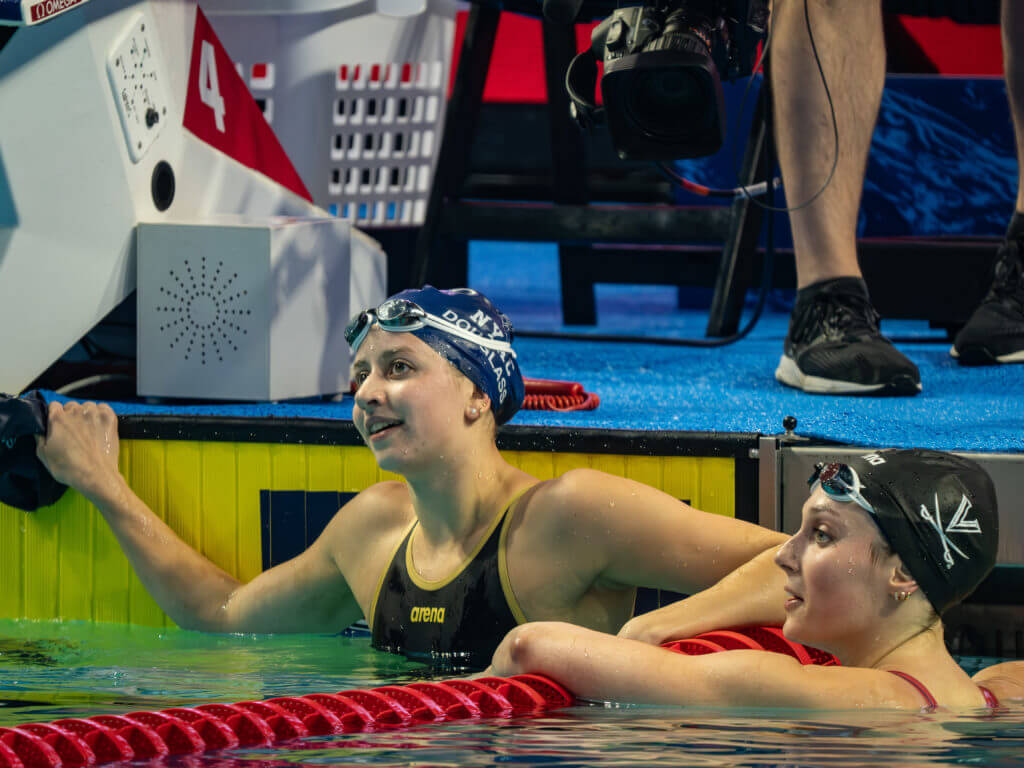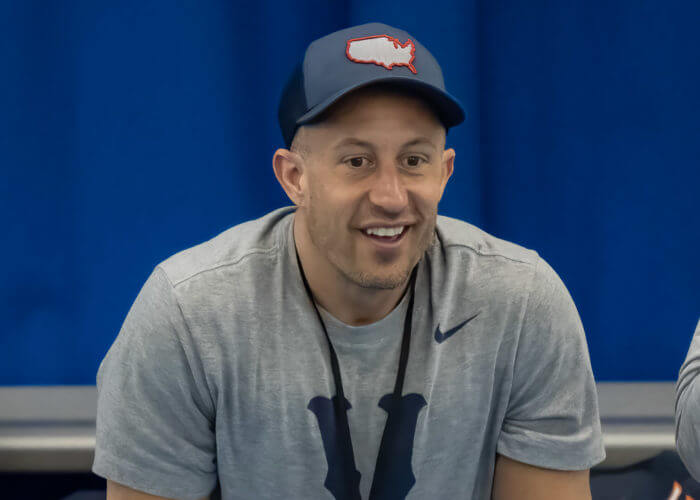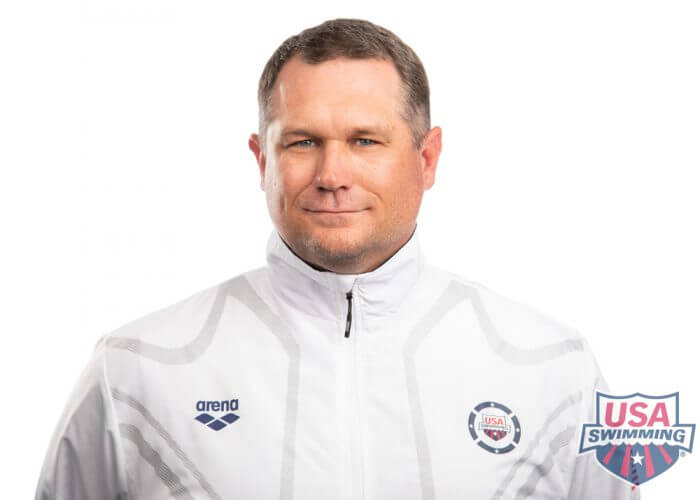The Complete Swimmer: Event Specialization and the Case for Varied Training

The Complete Swimmer: Event Specialization and the Case for Varied Training
By MICHAEL J. STOTT
We’ve all seen it—an age group phenom who dominates a particular stroke and claims it as his or her own. “Athletes will often self-identify their primary events. Those are dictated by genetics, attention to detail, previous history and personal history,” says Ben Keast, SwimMAC age group coach who earlier assisted at several Canadian High Performance Centers.
Past history and current day records are littered with such examples. Case in point: In 1983, Chas Morton set the still-standing USA Swimming 11-12 national age group record in the 100 meter fly (58.74). At 15, Michael Phelps set the world record in the 200 fly. Both were products of multi-disciplinary training.
As a 10-year-old swimming for Nashville aquatic coach, Joe Goeken, Morton held all the NAG short-course yards records (except for the 50 breast). He then held ALL the 11-12 NAG SCY marks. Later, NAC coaches Kris Kubik and John Morse helped elevate him to three USA Swimming National Teams and ultimately a successful career at Stanford. As for Phelps, he was quite versatile, too, earning 28 Olympic medals in a variety of strokes—including six in the IM.
In their lengthy careers as sports physiologists, Jan Olbrecht and Inigo Mujika posit that every athlete responds differently to training stimuli and peaking for performance. And while young swimmers have favorite events, experienced coaches see to it that they don’t become bound by early specialization. Ultimately, training, physical maturation and a host of other factors often find athletes excelling at strokes other than their early favorites.
TIME WAS…
When at the Dad’s Club in Houston years ago, Richard Quick worked with 12-year-old prodigy Keena Rothhammer. He suggested that rather than concentrate on the dorsal stroke, she vary her training because he saw a competitive opening for her at the 1972 Olympics in the 800 free. “My daughter is a backstroker,” pronounced her mother, who promptly moved her to Santa Clara to train with George Haines. Three years later, Rothhammer made the U.S. Olympic team and earned a gold medal…in the 800 freestyle.
Another who benefited from varied training was Tom Jager, world champion/record holder in the 50 freestyle, NCAA champion in the 100 back and whose first national cut was in the 1650 free. And how about Nathan Adrian, NCAA and Olympic champion in the 50 free? He had an incredible distance training base under age group coach Jay Benner. Among others who have benefited from diverse training include Leon Marchand, Kate Douglass and Gretchen Walsh.
CURRENT DAY
In what follows, a number of respected college and age group coaches provide perspectives on swim training and the role of specialization. The reader will note a consensus on the value of varied training—albeit with interesting tweaks:
Tyler Fenwick, senior associate head coach, University of Virginia

Photo Courtesy: Peter H. Bick
“Swimming other events leaves the door open for development in other things. Plus it’s fun for swimmers. Swimming the same thing every year can be a little boring. Kate Douglass didn’t come to Virginia as a 200 breaststroker, and she is now an Olympic champion in it.
“I don’t think there is ever a point when you should have straight specialization. You want to leave the door open and give swimmers options to explore. At Virginia, everyone trains IM—whether it is the 100, 200 or 400. And we’ve seen a lot of people discover new events at which they are really good.
“Especially age groupers, and that includes high school; it’s a crime to specialize in certain events. Youngsters are still developing, and it closes the door on some events. What we are looking for are kids who are Swiss Army knives, who don’t have a set mindset and are willing to look at other events.”
Whitney Hite, associate head coach, University of Florida
“I think every kid should swim every event. My son is on a high school team as a sixth grader. I want him to swim every event for as long as possible.
“Specialization, I don’t believe in it. You don’t want to be a one-trick pony. You can always learn from a race. Every race has the ability to be your race or event. That is how you learn.
“With kids, you never know. One swimmer came to me in college as a butterflyer, then set an American record, won an NCAA championship in the 200 back and was named Swimmer of the Year.”
Kimi Davidson, head age group coach, Mission Viejo Nadadores
“I believe that swimmers can begin focusing on a specific stroke or range (sprint, mid-distance, distance) around 16-18 years-old, depending on how high-level they are. However, that doesn’t mean only focus on that.
“Swimmers should still be doing multiple strokes and ranges, even throughout their college or pro careers. While an athlete may be recruited to a college team for a specific stroke/event, they should still practice and occasionally compete in others. This helps keep practices engaging, allows for occasional mental breaks at meets—not putting all the pressure on the same events meet after meet—and it helps athletes use/strengthen all muscle groups to be better athletes in general—not just doing movements or using muscle groups specific to one stroke. The same can be said for a post-grad swimmer as well.
“At MVN, our 14-and-unders are doing every event in the lineup, at least once, throughout the season; 10-and-unders are encouraged to do multi-sports/activities, and we expect them to come to swim if not at another sport practice.
“Every group, from beginner to elite, is doing movement activation prior to entry into any swim (practice, competition, etc.). For example:
- Gymnastic-like exercises are done at 12-and-under;
- Introduction to weight room (body weight programs) begins at 13-14 through high school;
- Weight-room exercises begin freshman year of high school.
“We value athleticism both on land and in the water at all ages in our program. We also value development training and drill progressions from 10-and under to 11-12 to 13-14 to 15-and-over in our dryland program. The purpose is to help athletes continue to grow and improve, as well as keep them engaged with new aspects to learn as they get older.”
Bill Doughty, head coach, DART Swimming (Davis, Calif.)
 “Our top 13-14 groups do pretty much the same workouts. They have sets that allow them to choose primary strokes. However, for the most part, they are doing the same workouts that are designed for more 200-level training, allowing them later to go up or down as needed. The activity really focuses heavily on kicking and building much of the aerobic base from their legs.
“Our top 13-14 groups do pretty much the same workouts. They have sets that allow them to choose primary strokes. However, for the most part, they are doing the same workouts that are designed for more 200-level training, allowing them later to go up or down as needed. The activity really focuses heavily on kicking and building much of the aerobic base from their legs.
“At 14 or in high school, swimmers have the ability to move to our senior groups.
“We have a large staff that allows additional coaches to come in and help run specific workouts for each group. We usually warm up together, do some kicking and technical work for the first hour, and then we break apart in groups for the second hour.
“Following is our thinking regarding different practice groups:
“Distance: Swimmers here may specialize in—and enjoy—longer events like 400 IM and 500 free. These athletes really have to have the mental toughness and understanding that this work will help them. A big workout for us is around 6,500 yards, so some may not even call this a distance group.
“Middle distance: This is more of a catch-all for swimmers who might be versatile or more 200 stroke kids. This group also has distance swimmers who just mentally can’t stay engaged for the longer sets.
“Sprint: This is our smallest group. I’m most strict with this group because I am doing these swimmers a disservice if they are in this group just because they are not hard workers. These swimmers truly have to have quick-twitch and explosive power. They are also our swimmers who struggle with aerobic work and who break down quickly.
“We find swimmers who just train better in certain cohorts even though they may technically fit better with another group. If they mentally can’t handle a certain style of workout, we make adjustments for them. I’d rather have them working hard with a specific technical focus than lap swimming.
“At our end-of-season evaluations. we assess what worked and what didn’t for each athlete. I’m honest with swimmers if I feel like they struggled with a specific type of work, or if the DART staff placed them in the wrong group. This season, I moved a girl down to sprint because I think I physically overworked her this summer. She never found her speed in taper because we had her overly broken down all season.
“A cautionary tale: Once we had two swimmers who trained in different groups achieve success in the same event. Swimmer-A and Swimmer-B both made the National Select Camp in the 400 IM. All kinds of coaches approached me about how DART was training 400 IMers. The two girls couldn’t have trained more differently. Swimmer-A hated to train IM, so she opted for more of a distance free-based training. Swimmer-B struggled even with a mid/sprint workout focus. Swimmer-B would have quit had I forced her to train distance free or longer IM. Interestingly, Swimmer-B later learned to enjoy training and finished seventh at Olympic Trials in the 200 IM. We did the best we could to set them both up for success while making sure not to run them off from the sport.
“Personally, I feel that not taking a more individual approach prioritizes the club over the athlete. Kids don’t fit into the ‘one-shoe-fits-all’ mode anymore. Mental health, social issues and external stresses are all so impactful on their daily lives. Our goal shouldn’t be to create more stress for kids by forcing them into our system. With careful thought, we can be more creative as coaches.”
Colin Kennedy, head age group coach, Fleet Swimming (Cypress, Texas)
“I believe all 14-and-unders should train for the 400 IM and 500 free, developing all four strokes, working to build up weaknesses and accentuating strengths. Programs need to be flexible enough to meet the coach goals for improvement/learning/development while also providing chances for kids to be themselves.
“Groups tend to look different by season, so this requires regular adjustments. One year, I had a lot of big strong boys who liked to race, and they needed more chances to do that in practice. It was easy and fun to find different challenges for them to learn and grow while doing what they liked. Another year, I had a lot of individuals whose best strokes were all different, and they all excelled in IM. That season was easy to plan as we always worked each stroke and let individuals shine on their best stroke day.
“Providing choices is key. If your plan is a 2,400 free set that’s just basic descending/aerobic, you can write that three different ways: 1) maybe 6 x 400s for kids who like longer repeats; 2) 8 x 100s/4 x 200s/2 x 400s so they get a mix; 3) 24 x 100s on descending intervals.
“All accomplish the same goal, but do not force someone into a set they will hate. You can do the same with stroke sets—choose from fly, back or free—or let them pick IM or free. The more opportunities swimmers have to pick, the more they seem to mix it up without being told—and if not, you can help them make a better choice.
“Focusing on 400 IM and 500 free means trying to build endurance and foundation. We do sprint sets and sprint days. We do pace days, test sets, emphasize kicking and turns/underwaters. You must teach it all. Then as athletes get bigger and stronger, they can specialize. Coaching an IM program doesn’t mean every day is IM. It does give you a lot of room for creativity when designing sets and progressive overload through a season and athlete-driven choice, which makes it fun and helps swimmers practice some independence.
“I do not have a specific age for specialization. We empower them to choose within coach-directed guidelines, giving kids options and letting them choose. I’m not going to force a swimmer to focus on distance swimming when they want to sprint. We want them to swim for years to come, so we’ll give them sprint stuff without ignoring their aerobic development—so they can swim 19-21 times at a champs meet. That’s our job as age group coaches.”
Russ Kasl, head age group coach, SwimMAC (Charlotte, N.C.)
“I coach SwimMAC’s top 11-12 and 13-14-year-old swimmers at our south site. Our approach for 14-and-unders is to move coaches toward being master generalists as they help swimmers develop proficiency in all events and strokes.
“Our approach during pre-puberty is exposing swimmers to—and working toward—successful development in a myriad of skills. We view this as an opportunity—without the advantage of Mother Nature—to develop all aspects within the swimmers’ control prior to any boost from their DNA.
“Such a concurrent training system involves the parallel development of several motor abilities—i.e., strength, speed and endurance—while producing multi-faceted physical fitness development. Much of this falls into what the swim community calls ‘IM-Based Training.’ Swimmers learn four different strokes—which involves four different kicks, pulling patterns, body movements, rhythm cycles, display of speed, etc.—four different starts and finishes, seven different turns, underwater travel/exiting each length, racing strategy, etc. And that’s just in the water.
“As for specifying events, we want swimmers to contribute to team success locally and nationally. That requires the ability to be successful in as many as eight events—that’s the meet limit at our age group championship meet. The USA Swimming Virtual Club Rankings allow for four events per swimmer to score. So, there must be quality of versatility as well as performance.” (Editor’s note: SwimMAC has won the last three Club Excellence rankings and has been a Gold Medal Club for the last 20 years.)
“Training versatility bolsters swimmer excitement, reduces rate of injury, develops movement patterns in multiple planes of position, affords individual opportunity to shine in best events and helps reveal other avenues.
“With the 13-14 group I coach, depending on where we are in the season, we do have a ‘main no-free day’ or times where we have specific sessions for sprint, mid-distance and distance freestylers, which allow swimmers to sharpen specific skills.
“In truth, the more the event window is narrowed, the fewer opportunities exist to be successful. However, at SwimMAC, we believe some specificity has value once swimmers move to our 15-and-over training and higher-level performance groups, and where the college decision impact becomes more relevant. At the end of our swimmers’ 13-14 careers, (their) strengths have been revealed, and so a conversation—and perhaps training—inevitably shifts toward maximizing swimmer potential while still considering contribution to team goals.
“For swimmers performing at a national or international level, accelerating training in specific events is appropriate and necessary. It also becomes much more individual—and highly specialized.”
BEYOND THE AGE GROUP YEARS
“At the apex of swimming, there is specialization,” avers Keast. “Athletes with the will and capability to be the best elect to specialize and stay specialized. And that applies to most professional swimmers,” he says. “In almost all cases, these elite athletes have benefited from comprehensive and robust training plans that have prepared them for a variety of races and moments of specialization that follow.”
Michael J. Stott is an ASCA Level 5 coach, golf and swimming writer. His critically acclaimed coming-of-age golf novel, “Too Much Loft,” is in its third printing, and is available from store.Bookbaby.com, Amazon, B&N and book distributors worldwide.



